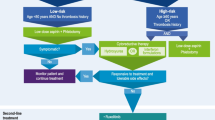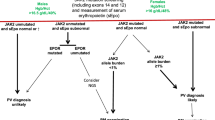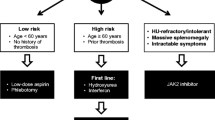Abstract
Hydroxyurea is an old drug that is often used to control essential thrombocythemia and polycythemia vera in patients with high-risk disease. It is usually well tolerated and cheap and has been proven effective in many studies for the prevention of thrombohemorrhagic complications associated with these disorders. However, many clinicians are reluctant to use it because of the perceived risk of progression to acute leukemia. Several recent, large studies have given this drug a new lease on life. Relevant results from these studies are discussed, and the risk of leukemia is placed in perspective to demonstrate that hydroxyurea remains the drug of choice in patients with either of these disorders.
Similar content being viewed by others
References and Recommended Reading
Fialkow PJ, Faguet GB, Jacobson RJ, et al.: Evidence that essential thrombocythemia is a clonal disorder with origin in a multipotent stem cell. Blood 1981, 58:916–919.
Tefferi A: The Philadelphia chromosome negative chronic myeloproliferative disorders: a practical overview. Mayo Clin Proc 1998, 73:1177–1184.
Tefferi A: A contemporary approach to the diagnosis and management of polycythemia vera [review]. Curr Hematol Rep 2003, 2:237–241.
Tefferi A: Myelofibrosis with myeloid metaplasia. N Engl J Med 2000, 342:1255–1265.
Tefferi A: Chronic myeloid disorders: classification and treatment overview. Semin Hematol 2001, 38:1–4.
Dameshek W: Some speculations on the myeloproliferative syndromes. Blood 1951, 6:372–375.
Passamonti F, Buser AS, Teo SS, et al.: Acquired mutation of the tyrosine kinase JAK2 in human myeloproliferative disorders. N Engl J Med 2005, 352:1779–1790.
Jones AV, Kreil S, Zoi K, et al.: Widespread occurrence of the JAK2 V617F mutation in chronic myeloproliferative disorders. Blood 2005, 106:2162–2168.
Lasho TL, Mesa R, Gilliland DG, Tefferi A: Mutation studies in CD3+, CD19+ and CD34+ cell fractions in myeloproliferative disorders with homozygous JAK2(V617F) in granulocytes. Br J Haematol 2005, 130:797–799.
Tefferi A, Gilliland DG: The JAK2V617F tyrosine kinase mutation in myeloproliferative disorders: status report and immediate implications for disease classification and diagnosis. Mayo Clin Proc 2005, 80:947–958.
Michiels JJ, Kutti J, Stark P, et al.: Diagnosis, pathogenesis and treatment of the myeloproliferative disorders essential thrombocythemia, polycythemia vera and essential megakaryocytic granulocytic metaplasia and myelofibrosis [review]. Neth J Med 1999, 54:46–62.
Michiels JJ, Barbui T, Finazzi G, et al.: Diagnosis and treatment of polycythemia vera and possible future study designs of the PVSG [review]. Leuk Lymphoma 2000, 36:239–253.
Barbui T, Barosi G, Grossi A, et al.: Practice guidelines for the therapy of essential thrombocythemia. A statement from the Italian Society of Hematology, the Italian Society of Experimental Hematology and the Italian Group for Bone Marrow Transplantation. Haematologica 2004, 89:215–232.
McMullin MF, Bareford D, Campbell P, et al.: Guidelines for the diagnosis, investigation and management of polycythaemia/erythrocytosis. Br J Haematol 2005, 130:174–195.
Rozman C, Giralt M, Feliu E, et al.: Life expectancy of patients with chronic nonleukemic myeloproliferative disorders. Cancer 1991, 67:2658–2663.
Mesa RA, Silverstein MN, Jacobsen SJ, et al.: Population-based incidence and survival figures in essential thrombocythemia and agnogenic myeloid metaplasia: an Olmsted County Study, 1976–1995. Am J Hematol 1999, 61:10–15.
Spivak JL: The optimal management of polycythemia vera [review]. Br J Haematol 2002, 116:243–254.
Tefferi A: Polycythemia vera: a comprehensive review and clinical recommendations. Mayo Clin Proc 2003, 78:174–194.
Landol. R, Marchioli R, Kutti J, et al.: European Collaboration on Low-Dose Aspirin in Polycythemia Vera Investigators: Efficacy and safety of low-dose aspirin in polycythemia vera. N Engl J Med 2004, 350:114–124.
Cortelazzo S, Finazzi G, Ruggeri M, et al.: Hydroxyurea for patients with essential thrombocythemia and a high risk of thrombosis. N Engl J Med 1995, 332:1132–1136. First randomized, controlled trial demonstrating the efficacy of hydroxyurea in preventing thrombosis in patients with high-risk essential thrombocythemia.
Finazzi G, Barbui T: Treatment of essential thrombocythemia with special emphasis on leukemogenic risk. Ann Hematol 1999, 78:389–392.
Tefferi A, Murphy S: Current opinion in essential thrombocythemia: pathogenesis, diagnosis, and management [review]. Blood Rev 2001, 15:121–131.
Tefferi A, Elliott MA, Solberg LAJr, Silverstein MN: New drugs in essential thrombocythemia and polycythemia vera. Blood Rev 1997, 11:1–7.
Najean Y, Rain JD: Treatment of polycythemia vera: the use of hydroxyurea and pipobroman in 292 patients under the age of 65 years. Blood 1997, 90:3370–3377.
Elliott MA, Tefferi A: Interferon-alpha therapy in polycythemia vera and essential thrombocythemia. Semin Thromb Hemost 1997, 23:463–472.
Silver RT: Treatment of polycythemia vera with recombinant interferon α (rIFNα) or imatinib mesylate. Curr Hematol Rep 2005, 4:235–237.
Silver RT: Imatinib mesylate (Gleevec™) reduces phlebotomy requirements in polycythemia vera. Leukemia 2003, 17:1186–1187.
Dresler WFC, Stein R: Uber den hydroxylharnstoff. Justus Liebigs Ann Chem Pharm 1869, 150:242–252.
Rosenthal F, Wislicki L, Kollek L: Uber die beziehungen von schwersten blutgiften zu abbauprodukten des eiweisses: Ein beitrag zum entstehungsmechanismus der perniziosen anamie. Klin Wochenschr 1928, 7:972–977.
Stearns B, Losee KA, Bernstein J: Hydroxyurea: a new type of potential antitumor agent. J Med Chem 1963, 35:201.
Wright JA, Chan AK, Choy BK, et al.: Regulation and drug resistance mechanisms of mammalian ribonucleotide reductase, and the significance to DNA synthesis. Biochem Cell Biol 1990, 68:1364–1371.
Nocentini G: Ribonucleotide reductase inhibitors: new strategies for cancer chemotherapy [review]. Crit Rev Oncol Hematol 1996, 22:89–126.
Navarra P, Preziosi P: Hydroxyurea: new insights on an old drug. Crit Rev Oncol Hematol 1999, 29:249–255.
McGinn CJ, Kinsella TJ: The experimental and clinical rationale for the use of S-phase-specific radiosensitizers to overcome tumor cell repopulation. Semin Oncol 1992, 19:21–28.
Rosner F, Rubin H, Parise F: Studies on the absorption, distribution, and excretion of hydroxyurea (NSC-32065). Cancer Chemother Rep 1971, 55:167–173.
Volpe AR, Navarra P, Preziosi P: Blood and brain hydroxyurea levels: relationship with adrenocortical activation. Arch Int Pharmacodyn Ther 1989, 298:301–302.
Gwilt PR, Tracewell WG: Pharmacokinetics and pharmacodynamics of hydroxyurea. Clin Pharmacokinet 1998, 34:347–358.
Finazzi G, Ruggeri M, Rodeghiero F, Barbui T: Second malignancies in patients with essential thrombocythaemia treated with busulphan and hydroxyurea: long-term follow-up of a randomized clinical trial. Br J Haematol 2000, 110:577–583. In this randomized study, the authors find no evidence for an increase in the risk of acute leukemia in patients with essential thrombocythemia who are treated with hydroxyurea alone.
Dingli D, Tefferi A: A critical review of anagrelide therapy in essential thrombocythemia and related disorders. Leuk Lymphoma 2005, 46:641–650.
Harrison CN, Campbell PJ, Buck G, et al.; United Kingdom Medical Research Council: Hydroxyurea compared with anagrelide in high-risk essential thrombocythemia. N Engl J Med 2005, 353:33–45. Landmark randomized controlled study that clearly demonstrates the superior efficacy of hydroxyurea compared with anagrelide in patients with essential thrombocythemia.
Kaplan ME, Mack K, Goldberg JD, et al.: Long-term management of polycythemia vera with hydroxyurea: a progress report. Semin Hematol 1986, 23:167–171.
Fruchtman SM, Mack K, Kaplan ME, et al.: From efficacy to safety: a Polycythemia Vera Study group report on hydroxyurea in patients with polycythemia vera [review]. Semin Hematol 1997, 34:17–23.
Silver RT: Interferon alfa: effects of long-term treatment for polycythemia vera. Semin Hematol 1997, 34:40–50.
Finazzi G, Caruso V, Marchioli R, et al., ECLAP Investigators:Acute leukemia in polycythemia vera: an analysis of 1638 patients enrolled in a prospective observational study. Blood 2005, 105:2664–2670. In this study, the risk of acute myeloid leukemia in patients with polycythemia vera treated with hydroxyurea is put in perspective. The safety of hydroxyurea when used alone is clear from the large cohort of patients studied.
Andersson PO, Ridell B, Wadenvik H, Kutti J: Leukemic transformation of essential thrombocythemia without previous cytoreductive treatment. Ann Hematol 2000, 79:40–42.
Treatment of polycythaemia vera by radiophosphorus or busulphan: a randomized trial. "Leukemia and Hematosarcoma" Cooperative Group, European Organization for Research on Treatment of Cancer (E.O.R.T.C.). Br J Cancer 1981, 44:75–80.
Berk PD, Goldberg JD, Silverstein MN, et al.: Increased incidence of acute leukemia in polycythemia vera associated with chlorambucil therapy. N Engl J Med 1981, 304:441–447.
Najean Y, Rain JD, Dresch C, et al.: Risk of leukaemia, carcinoma, and myelofibrosis in 32P- or chemotherapytreated patients with polycythaemia vera: a prospective analysis of 682 cases. The "French Cooperative Group for the Study of Polycythaemias" [review]. Leuk Lymphoma 1996, 22(Suppl 1):111–119.
Chabes A, Thelander L: Controlled protein degradation regulates ribonucleotide reductase activity in proliferating mammalian cells during the normal cell cycle and in response to DNA damage and replication blocks. J Biol Chem 2000, 275:17747–17753.
Najean Y, Rain JD: Treatment of polycythemia vera: use of 32P alone or in combination with maintenance therapy using hydroxyurea in 461 patients greater than 65 years of age. The French Polycythemia Study Group. Blood 1997, 89:2319–2327.
Halsey C, Roberts IA: The role of hydroxyurea in sickle cell disease [review]. Br J Haematol 2003, 120:177–186.
Erratum appears in Br J Haematol 2003, 121:200.
Sterkers Y, Preudhomme C, Lai JL, et al.: Acute myeloid leukemia and myelodysplastic syndromes following essential thrombocythemia treated with hydroxyurea: high proportion of cases with 17p deletion. Blood 1998, 91:616–622.
Finazzi G, Ruggeri M, Rodeghiero F, Barbui T: Efficacy and safety of long-term use of hydroxyurea in young patients with essential thrombocythemia and a high risk of thrombosis. Blood 2003, 101:3749.
Oskay T, Kutluay L, Ozyilkan O: Dermatomyositis-like eruption after long-term hydroxyurea therapy for polycythemia vera. Eur J Dermatol 2002, 12:586–588.
Perrot JL, Cambazard F: Cas pour diagnostic: pseudodermatomyosite a l’Hydrea [case report, French]. Ann Dermatol Venereol 1994, 121:499–500.
Young HS, Khan AS, Kendra JR, Coulson IH: The cutaneous side-effects of hydroxyurea. Clin Lab Haematol 2000, 22:229–232.
Yoshida K, Saito M, Amagai M, Ikeda Y: Gottron-like papules induced by hydroxyurea. Clin Exp Dermatol 2005, 29:605–607.
Salmon-Ehr V, Grosieux C, Potron G, Kalis B: Multiple actinic keratosis and skin tumors secondary to hydroxyurea treatment [case reports, letter]. Dermatology 1998, 196:274.
Esteve E, Georgescu V, Heitzmann P, Martin L: Carcinomes cutanes et buccaux multiples apres traitement par l’hydroxyuree [case reports, French]. Ann Dermatol Venereol 2001, 128:919–921.
De Benedittis M, Petruzzi M, Giardina C, et al.: Oral squamous cell carcinoma during long-term treatment with hydroxyurea. Clin Exp Dermatol 2004, 29:605–607.
Westerman DA, Schwarer A, Grigg AP: Hydroxyureainduced fever and hepatitis [case reports]. Aust N Z J Med 1998, 28:657–659.
Grace RF, Shenfield GM, Grant J, Ravich R: Recurrent pyrexia, cough and dyspnoea with hydroxyurea [case report, letter]. Aust N Z J Med 1998, 28:347.
Blanc PL, Joasson JM, Hammoud H, Matussiere Y: [Acute interstitial pneumopathy with fever caused by hydroxyurea] [case reports, French]. Presse Med 2000, 29:242–245.
Schwonzen M, Spangenberger H, Spengler M: Hydroxyurea-induzierte pneumonitis [case reports, German]. Med Klin (Munich) 2003, 98:394–397.
Roa D, Kopsombut P, Aguinaga MP, Turner EA: Hydroxyurea-induced denaturation of normal and sickle cell hemoglobins in vitro. J Clin Lab Anal 1997, 11:208–213.
Jabr FI, Shamseddine A, Taher A: Hydroxyurea-induced hemolytic anemia in a patient with essential thrombocythemia [case report]. Am J Hematol 2004, 77:374–376.
Author information
Authors and Affiliations
Corresponding author
Rights and permissions
About this article
Cite this article
Dingli, D., Tefferi, A. Hydroxyurea: The drug of choice for polycythemia vera and essential thrombocythemia. Curr Hematol Malig Rep 1, 69–74 (2006). https://doi.org/10.1007/s11899-006-0025-4
Issue Date:
DOI: https://doi.org/10.1007/s11899-006-0025-4




